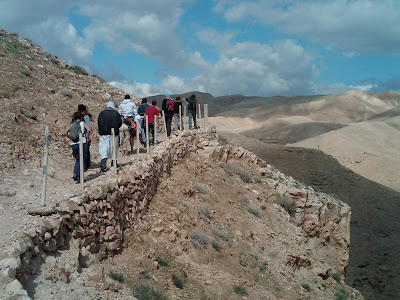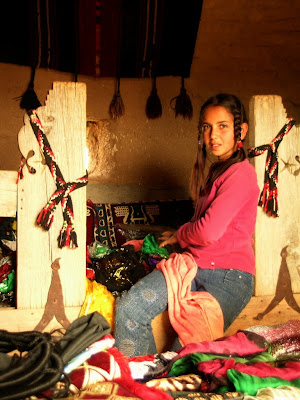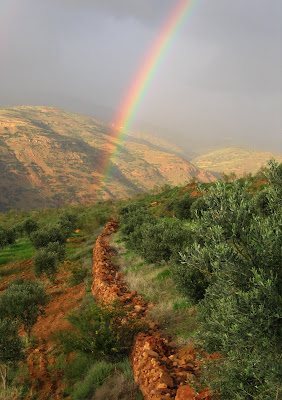We've found an incredible resource for exploring global citizenship, through a walking path that promotes deep learning of culture, people, and place. Abraham's Path is a route that has been described in many cultures and religions. By following Abraham's Path, travelers can explore history and culture, while promoting sustainable tourism. We were lucky enough to sit down and talk with Joshua N. Weiss, Ph.D., Managing Director, The Abraham Path Initiative; Co-Founder and Senior Fellow, Global Negotiation Initiative, Harvard Negotiation Project. Here's what he had to say...
WE: Please tell us about your site, Abraham's Path...
JW: Abraham's Path is a long distance walking and traveling route that follows the path that Abraham took some 4000 years ago. We are not creating anything new, rather we are simply dusting off the footprints of an ancient path. The path itself is being revised by the local communities where the path traverses -- the non profit entity helping to support it is doing so with funding, partnerships, and publicity.
At this point in time the path is very much in its initial stages. There is approximately 350 miles of non contiguous route that has been developed in Turkey, Jordan, the Palestinian Territories, and Israel. Each place has between 20 and 75 miles of path that is in use by travelers and the local community.

walking in the Wadi Quelt in the Palestinian Territories
WE: What was the genesis of your site?
JW: The genesis of the path came from a project called the Global Negotiation Initiative at Harvard University. The founder is a man named William Ury, who saw the path as a cultural diplomacy project. The path is a way of bringing people from around the world to the Middle East to have a unique cultural experience, to meet the local people where they are, and to walk with them side by side in a journey of exploration and mutual understanding.
WE: Where does Abraham's Path lead? How were you able to plot the route?
JW: Abraham's Path follows the different narratives associated with Abraham. This means that the path follows the Bible, Koran, and local folklore about the travels and wanderings of Abraham and his family. The route was initially delineated by charting the recountings from these texts. On the ground work was done by teams using GPS and traditional paths and routes that have been used by local people for centuries. The path does not claim historical accuracy because there is no archeological evidence that Abraham actually existed. Rather, the path follows Abraham in the spirit in which he has been captured over the ages.
WE: How can readers participate in retracing this incredible journey?
JW: Readers are welcome to travel any and all the segments that are currently in use. If they go to the Abraham Path website, they can find where they might like to go. They can also find information about homestay programs and other logistical matters. If they have further questions or require any assistance they can simply email us at travel[at]abrahamspath.org
There are also other ways for people to participate. People have organized Abraham walks in their own cities and towns. Others have helped to fund people to go on the path. Finally, there is a virtual path section of the website so people can explore the path and learn about the places along it without ever leaving their homes.
WE: What activities are available for students?
JW: There are a number of activities available for students. To get a general idea of the experience that is possible, students may want to watch a short film about the first student exchange that took place on the path.
There are many community service oriented projects along the path, from painting schools on the path to helping the locals during olive harvesting season. Groups of students with a particular focus can also contact us in order to ensure that their learning targets their area of interests.
Examples of these specific areas have been Political Science, Archeology, Tourism, Anthropology, and Peace and Conflict Resolution. Most students travel during winter break, spring break, or in the summer.
Finally, we have had a number of students use the path as a subject for their research and academic work. One student created an experiential learning curriculum for university youth to use on the path. Another looked at how to develop the path with a responsible tourism lens to minimize the potential harm to the local communities. And others have used it to analyze conflicts in the Middle East region from a grassroots perspective.
WE: How has this journey worked, interculturally, for both locals and participants
JW: The journey, as reported by both the locals and internationals, has been very impactful in numerous ways. Travelers report that they come to understand an unreported side of the Middle East -- one steeped in the values associated with Abraham...respect, hospitality, and friendship.
There has yet to be a person who has traveled (over 4,000 have been on the path since 2007) that has not reported some change in their perception as a result of traveling on the path. Those travelers have really gotten the most out of the homestay program, sharing meals with local families, and
learning the culture and customs of the people in fun and entertaining ways.
From the local perspective, a story best describes part of the impact of the path. In Ajloun, one of the poorest regions of Jordan, families have been able to increase their income by $125 per month by providing services to travelers on the Path. An example is Um-Ahmad, a hard-working woman from this region who supports her family of seven children and a disabled husband. She has struggled to earn a living in Ajloun, and poverty forced her to marry off her eldest daughter at the age of 15 years old.
The Abraham Path Initiative first encountered Um-Ahmad when she offered to make bread at one of its markets. That experience inspired Um-Ahmad to create a business of her own, baking bread -³Taboon². Because of her skill, the Abraham Path Initiative hired Um-Ahmad to prepare meals for tourists in Ajloun. Travelers could stop by her home for a hot meal. This simple stop was a turning point for Um-Ahmad and her family. She now generates a steady income enabling her to renovate her humble house, including their only toilet, which was previously dysfunctional. As the path continues to develop, the initiative is working to replicate this success in more communities.

young Turkish girl near the path in Harran making handicrafts
WE: This area of the world is so divided, both politically and in terms of religion. How can Abraham's Path cross that divide, and educate for peace?
JW: Abraham's Path is serving as a vehicle for all kinds of activity...a platform if you will. The more local people interact and cooperate across conflict lines -- in very practical ways -- such as passing travelers from one place to another, the more they build relationships that transcend politics.
One of the reasons the path has come to life in the way that it has is because all the places along the path see tourism as a critical part of their future. This very functional approach helps improve peoples daily lives and gives them an opportunity to envision a better and different future. Without meeting these basic needs it is very hard for people to think about a more peaceful future. The path makes this happen slowly -- step by step.

rainbow over the countryside on the path in northern Jordan, near an area called Ajloun
WE: Is there anything else you'd like to share with us?
JW: Just simply that the path is still in its nascent phase of development and is open to all different forms of co-creation. We welcome people with their ideas and partnership opportunities. The path is only limited by peoples creativity -- come experience the path, help build it, and help make it something that last for generations.
WE: Thanks so very much, Josh. Abraham's path is an extraordinary learning opportunity.
